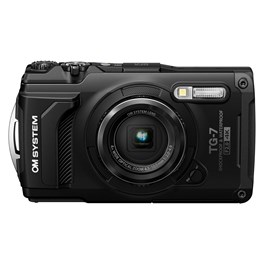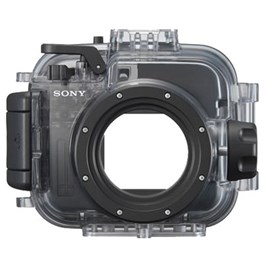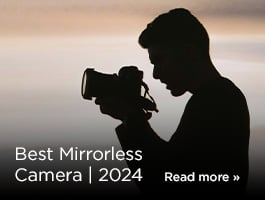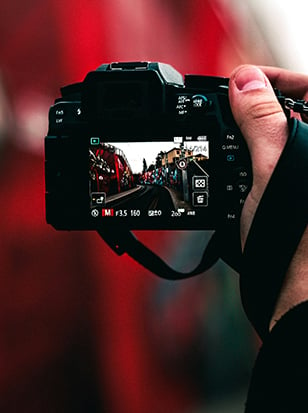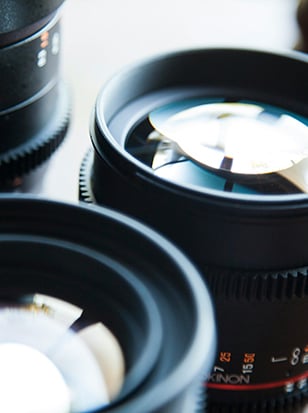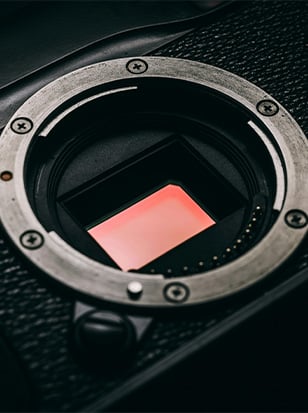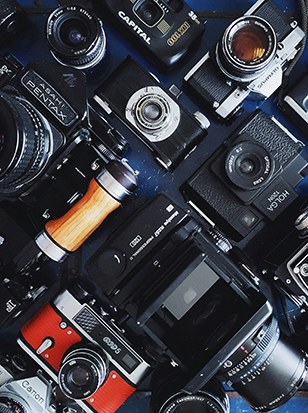
The best underwater cameras and accessories give you a whole new frontier to explore! Either by equipping yourself with waterproof digital cameras or by outfitting your regular camera, DSLR or mirrorless with underwater housing, you can take things in a whole new direction.
In this guide, we’re going to take you through everything you need to know about underwater photography and the best cameras for underwater photos and videos. But first things first, here's what we'll cover in this guide:
Action Cameras: are small, affordable, and built for durability. These pocketable devices are ideal for shallow waters or watersports and often feature high-quality video recording. However, their wide-angle lens is fixed, and they lack zoom. They also cannot be used in deep water, which makes them best suited for casual users who prioritise portability.
Tough Cameras: or underwater compacts, are rugged versions of entry-level cameras with optical zoom lenses, making them a step up from action cameras in versatility. Easy to use and beginner-friendly, they’re perfect for families and holidaymakers. However, their small sensors mean they can struggle in low light, and they don’t support many add-ons.
Underwater Camera Housing: is what you need if you're looking for professional-level image quality. These waterproof cases allow you to take your standard camera underwater, preserving most of its features. They can handle greater depths and provide the best results but are bulkier, more expensive, and may require additional accessories.
Okay, with that covered, let's get into the Best Underwater Cameras and Waterproof Housing
Best Underwater Cameras
You don’t need to spend a lot of money to shoot underwater. There are loads of great budget underwater cameras out there, and provided you don’t need to dive too deep, they will reliably take underwater images and videos. For underwater shooting, you can look at action cameras, which are optimised for video, or tough cameras, which tend to be geared a little more towards photography. Here are our picks from both categories...
OM SYSTEM Tough TG-7 Digital Camera - Black
Venture further, dive deeper, and unveil more detail with OM SYSTEM’s Tough TG-7 12MP digital camera. Lightweight, compact, and rugged enough for outdoor enthusiasts, the TG-7 is waterproof to an impressive depth of 15m, shockproof to 2.1m, crushproof up to 100kg, and freezeproof at -10°C. It also boasts 4K video, an f2 wide 25-100mm 4x optical zoom lens, and a 12-megapixel backlit CMOS sensor.
£449.00 View
|
Pros:
Con:
|
Top Specs:
|
The OM System Tough TG-7 is arguably the best waterproof camera you can buy. It’s a tough compact, meaning it has more of a traditionally ‘camera-like’ form factor than a GoPro or a DJI Osmo. While this makes it less wearable than those dinky machines, it does make it easier to hold and shoot with, which is great for underwater exploring. Equipped with a 25-100mm equivalent zoom lens, the TG-7 also offers a number of creative shooting modes, including several designed for macro (close-up) photography. It does have a fairly small 1/2.3-inch sensor, which limits dynamic range and low-light performance. However, this is simply par for the course with waterproof cameras — realistically to do better, you’ll need a dedicated camera and housing.
What really sets the TG-7 apart in underwater terms, however, is the fact that you can add the PT-059 underwater housing to extend its waterproofing depth of 45m. This puts it head and shoulders above its competition, and it’s worth factoring in as well that you can use the Olympus LG-1 LED Light underwater, further augmenting your setup. A fantastic tough camera for serious photographers, the Tough TG-7 is a superb underwater compact camera.
Kodak Pixpro WPZ2 Digital Camera - Red
The Kodak Pixpro WPZ2 Digital Camera snaps 16-megapixel images and supports 1080p full HD video recording in a rugged, waterproof, and shock-proof casing. Enjoy 4x optical zoom and multiple shooting modes with image stabilisation. Connect to WiFi for effortless sharing and never miss a moment thanks to the rechargeable lithium-ion battery, which can capture up to 2000 shots or 70mins of video.
£149.00 View
|
Pros:
Cons:
|
Top Specs:
|
Part of a range of affordable compact cameras released by Kodak brand licensee JK imaging, the Pixpro WPZ2 is a cheap and cheerful waterproof option that’s perfect for holidays on the beach with kids. Waterproof down to 15m, it’s also hardy enough to stand a drop or two, and comes in an attractive range of colourways. Handily, it’s also equipped with face, eye and smile detection, which is great news for anyone wanting to capture holiday group shots.
While the image quality from this little camera isn’t going to measure up to that of high-end mirrorless models, it acquits itself pretty well, and benefits from a 4x optical zoom lens that gives you a decent amount of shooting flexibility. There’s no viewfinder to speak of — you’ll need to compose using the rear LCD screen, which is on the small side at 2.7 inches and has a relatively low resolution of 230K dots.
DJI Osmo Action 5 Pro Adventure Combo
The DJI Osmo Action 5 Pro camera offers stunning image quality with a 1/1.3” CMOS sensor, 40MP resolution, and 13.5 stops of dynamic range. It captures 4K/120fps video with an ultra-wide 155° FOV, and dual OLED touchscreens for ease of use. With 4 hours of battery life and advanced 360° HorizonSteady stabilisation, the Action 5 Pro delivers smooth footage and precise subject tracking for any adventure.
£325.00 View
|
Pros:
Cons:
|
Top Specs:
|
DJI’s Osmo Action 5 Pro is the latest salvo across GoPro’s bow — a highly specced waterproof action camera that does just about everything. With a generously sized sensor, it does brilliantly in low light, and can shoot 40MP images with plenty of detail. The 360° HorizonSteady and RockSteady 3.0 stabilisation modes make it easier to capture smooth and stable video, even when the camera is moving significantly (i.e. you’ve attached it to the front of your surfboard or whatever else). New to this model is also intelligent subject tracking, which can detect a subject’s position in the frame and adjust the composition to keep them centred in the frame.
With a native waterproof depth of 20m, the Osmo Action 5 Pro is a naturally deep diver, and this can be extended significantly to a scuba-friendly 60m with the addition of the Waterproof Case.
GoPro HERO13 Black
HERO13 Black is the camera for every creator. In addition to best-in-class 5.3K60 video and legendary GoPro durability, it’s compatible with new HB-Series Lenses. These lenses expand your capture capabilities for the most immersive POV shots, the ability to focus closer than ever, easy-to-achieve motion blur, and cinematic anamorphic footage. A new more powerful Enduro battery extends recording time in all weather conditions, while an updated mounting system gives HERO13 Black more mounting flexibility than any GoPro before it. With essential GoPro features including award-winning HyperSmooth 6.0 video stabilisation, automatic highlight videos and the ability to auto upload your footage to the cloud, HERO13 Black is a powerful combination of leading-edge tech and endless creative possibilities.
£289.00 View
|
Pros:
Cons:
|
Top Specs
|
The latest GoPro Hero camera is better than ever, inheriting everything that was great about its twelve predecessors while bringing new features to the table. It still packs a larger 8:7 format sensor that makes it easier than ever to shoot in different aspect ratios — perfect for those who want to capture vertical video for socials, as well as video in classic widescreen format. And it still packs a nice, big Enduro battery, a best-in-class stabilisation system, and the option to shoot Log footage for post-production grading.
What the Hero13 Black adds is a system of lens modules that let you further customise how it shoots. The HB-Series Lenses (sold separately) let you change the look of your images, with options like the Ultra-Wide Lens Mod for capturing a huge field of view, or the Macro Lens Mod for getting in close to your subjects.
Insta360 Ace Pro Splash Kit
Capture your adventures in stunning clarity with the Insta360 Ace Pro, the first action camera to support 8K video. Co-engineered with Leica, it’s waterproof up to 10m and has a powerful 1/1.3” sensor that offers 4K 120fps slow motion and 48MP photos. This splash kit includes a 64GB memory card, an Insta360 Ace Pro Float Guard, and an Insta360 Ace Pro Dive Case for recording underwater footage.
£305.00 View
|
Pros:
Cons:
|
Top Specs
|
If you want top-quality video of your underwater adventures, the Insta360 Ace Pro will deliver. It’s capable of capturing video in 8K resolution, beating both GoPro and DJI’s currency flagship action cameras, and can also capture 4K at 120fps for super-slow motion footage. Stills-wise, it manages a maximum resolution of 48MP, which gives you lots of detail to work with. Thanks to the sensor and lens that have been co-developed with Leica, imagery captured on the Insta360 Ace Pro looks fantastic.
We’d recommend that underwater photographers opt for the Splash Kit. Not only do you get the diving case that extends the waterproofing from 10m to 60m, but there’s also a handy Float Guard to prevent it from sinking — many action camera users are blissfully unaware that action cameras do not natively float, and in some cases, remain unaware of this until too late.
Best Underwater Camera Housings
If you’re more serious about underwater photography, an underwater housing is the way to go. These are effectively waterproof shells that fit around a camera, allowing you to still operate the controls while keeping the valuable electronics safe from harm.
They tend to be able to handle much greater depths than tough cameras and action cameras, and also have the advantage of allowing you to use a regular camera, which likely has a superior sensor to a standard tough camera. The trade-off is that underwater housings add expense and are considerably more cumbersome than a natively tough camera. But ultimately, if you want to shoot underwater, this is your best option.
AQUATECH EDGE for Canon R5

The AQUATECH EDGE Housing for Canon R5 offers up to 10m of reliable underwater protection. Its tactile controls, ergonomic design, and compatibility with AquaTech's P-Series lens ports ensure easy handling and versatile shooting options. Made from durable materials, it features quick-release clips for secure closure and push-button controls to access essential camera functions. Capture aquatic moments with confidence and precision.
£1,799.00 View
AQUATECH EDGE for Sony A9 III

The AQUATECH EDGE Housing for Sony A9 III offers up to 10m of reliable underwater protection. Its tactile controls, ergonomic design, and compatibility with AquaTech's P-Series lens ports ensure easy handling and versatile shooting options. Made from durable materials, it features quick-release clips for secure closure and push-button controls to access essential camera functions. Capture aquatic moments with confidence and precision.
£1,799.00 View
|
Pros:
Cons:
|
Top Specs:
|
If you’re looking to capture high-quality underwater images, AquaTech’s housings are some of the best in the business. The range consists of a huge number of bespoke housings for various different cameras — more than we can list here, with more being added all the time. Want to take your medium format Fujifilm GFX 100 II under the sea? There’s an Aquatech for that. Your full-frame Nikon Z8? There’s an Aquatech for that. Sony FX30 cine camera? You get it.
There’s also a range of accessories you can pick up to make handling underwater easier, such as extra handles and grips, as well as a carry bag for transportation. The Edge, Edge Base and Edge MAX housings all allow you to bring your camera down to depths of 10m, and while that may not be as deep as a tough compact will go, the image quality you’ll be able to get will absolutely blow it out of the water. It’s undoubtedly an expensive option, and the Aquatech Edge housings are only really available for expensive cameras — see below for some housings that suit cheaper cameras you can buy second hand.
Sony Marine Pack MPK-URX100A
The Sony Marine Pack MPK-URX100A allows you to dive to 40m/130ft with your Sony RX100 series camera. Dual gaskets offer double waterproof reliability, and it is designed to perfectly fit the compact the RX100-series cameras whilst allowing use of the built-in flash. It features an accessory shoe to attach an optional flashgun, a large shutter button and zoom levers, and a 67mm filter mount.
£320.00 View
|
Pros:
Cons:
|
Top Specs:
|
Canon WP-DC55 Underwater Case for PowerShot G7 X Mk II
Able to dive down to 40m, the Canon WP-DC55 Underwater Case allows you to use your PowerShot G7X MKII underwater. The form-fitting clear plastic polymer construction not only protects the camera when submerged, but also ensures your shots are clear and vivid. It features a diffuser for the camera's inbuilt flash, a flat port to protect the lens, and access to the camera's controls.
£299.00 View
|
Pros:
Cons:
|
Top Specs:
|
The Canon PowerShot G7 X Mark II has proven popular with a host of users, from amateur photographers to YouTubers. While it’s been discontinued and isn’t available new, it’s commonly available on the second-hand market. The Canon WP-DC55 Underwater Case is a case specifically for this compact camera, allowing it to be used up to 40m underwater.
The clear-plastic construction of the housing is designed to protect the camera while preserving as much image quality as possible. Handily, it features a diffuser for the G7 X II’s built-in flash (built-in flash is a much more useful tool for underwater photography than it is on land).
While there’s no 4K capabilities on the G7 X Mark II, its Full HD video looks fantastic – there’s a reason it’s become hugely popular among YouTubers. It’s capable of burst-shooting stills at up to 8fps, and has a generous shot buffer that’ll let you capture a good number of images.
|
Pros:
Cons:
|
Top Specs:
|
Formerly one of Canon’s flagship compacts, the Canon PowerShot G X Mark III is a hugely impressive machine and while discontinued, is still available second-hand. Packing an APS-C sensor into its relatively diminutive body, it offers image quality that’s streets ahead of any tough camera. Its lens is a 24-72mm equivalent optic, with a variable maximum aperture of f2.8-5.6.
Having the Canon Waterproof Case WP-DC56 allows you to take the G1 X Mark III down to depths of 40m. The case features a built-in diffuser for the on-camera flash, and offers easy access to most camera functions.
With Canon’s Dual Pixel CMOS autofocus system and good high-ISO performance, the PowerShot G1 X Mark III ticks a lot of boxes for underwater photographers. It’s basically a little DSLR, and merits serious consideration for any underwater photographer.

Browse our full range of underwater photography equipment »
Underwater Photography Tips
So, you’ve got your underwater camera and it’s time to get started with underwater photography! Here are a few tips and good things to remember so you can ensure you get the best images possible.
Try out the gear before you dive
Whether you’re using a simple compact camera or a more complicated setup involving a housing, it’s worth making sure you’re comfortable using it before you head underwater. Figuring out how a new camera works can be tricky enough – no need to make it harder on yourself by trying to do it underwater! Spend some time online making sure you’re comfortable with your camera controls, and you’ll maximise the effectiveness of your time underwater.
Don’t shoot alone
This goes double if you’re diving, but even if you’re messing about in shallower water, it pays to have a buddy there to look out for you. Try to always be with at least one other person on your underwater shoots, and you’ll be able to keep an eye on each other in case something goes awry.
Shoot in RAW if you can
It’s murky down there, and you may find that even with flash, your camera struggles to pick out details. If your camera gives you the option to shoot in RAW format, you will find that it gives you much more latitude to get a usable image when you come to editing the shots. Shooting in RAW will also mean you have to worry less about settings like white balance – can be fiddly to change underwater – as you’ll be able to correct any issues in post.
Remember how depth affects your images
The deeper you go underwater, the less light you’re going to have to work with. Skin tones will look pretty vibrant just below the surface, but once you start going deeper, they’ll start to lose their lustre and look quite drab. You’ll get more of a green/blue colour cast too. Using flash and, again, shooting in RAW are good ways to counteract this.
Get close
The lack of light underwater significantly reduces your camera’s vision, even with flash, and this means you need to be much closer to your subjects than you would normally. As a rule of thumb, try to get closer than you think you need to for the best results.
Dive in the sun
For all this talk of the lack of light underwater, one of the best things you can do to mitigate the issue is simply to try and time your underwater shoots for bright sunny days! You’ll be amazed at the difference it makes, particularly to the quality of the water near the surface, and you’ll find your images look much better as a result. Just remember to use sunblock!
FAQs
What type of camera is best for underwater photography?
It depends on your needs. For casual snorkelling or watersports, action cameras are compact and easy to use. Tough cameras are better for beginners who want optical zoom and simplicity. For advanced or professional-level photography, underwater housings for standard cameras offer superior quality and depth capabilities.
How deep can underwater cameras go?
Depth limits vary by camera type. Most action cameras and tough cameras are waterproof to around 10–15 metres, while professional underwater housings can reach depths exceeding 60 metres, depending on the model. Always check the manufacturer’s specifications.
Do I need extra lighting for underwater photography?
Yes, as natural light diminishes quickly underwater. A flash or underwater light is essential for capturing clear, vibrant shots, especially at greater depths where colours fade. Many underwater systems support external lighting for this purpose.
What accessories should I consider for underwater photography?
Useful accessories include wrist straps to secure the camera, high-capacity waterproof memory cards to prevent storage issues, and underwater lighting for better image clarity. Accessories enhance safety and help improve image quality.
What’s the best way to prepare for underwater photography?
Practice with your camera or housing on land first to familiarise yourself with the controls. Plan your shoot for bright, sunny days for optimal natural light, and always have a buddy with you for safety. Shooting in RAW format can help you edit for better results later.
How do we decide?
Our in-house photography experts, store staff and partners all work collaboratively to pour over our guides and tips articles. We also consider emerging trends and customer feedback to make sure our guides are always up-to-date and reflective of what people are truly looking for. By curating only the best products, our guides provide trustworthy recommendations, making it easier for customers to make informed choices with confidence.
If you would like more advice on any purchase our contact centre staff are here to help. Alternatively, you can reach us via email or social media. And don't forget. If you were to purchase anything based on our recommendations you'll be covered by our full returns policy
Sign up for our newsletter today!
- Subscribe for exclusive discounts and special offers
- Receive our monthly content roundups
- Get the latest news and know-how from our experts

